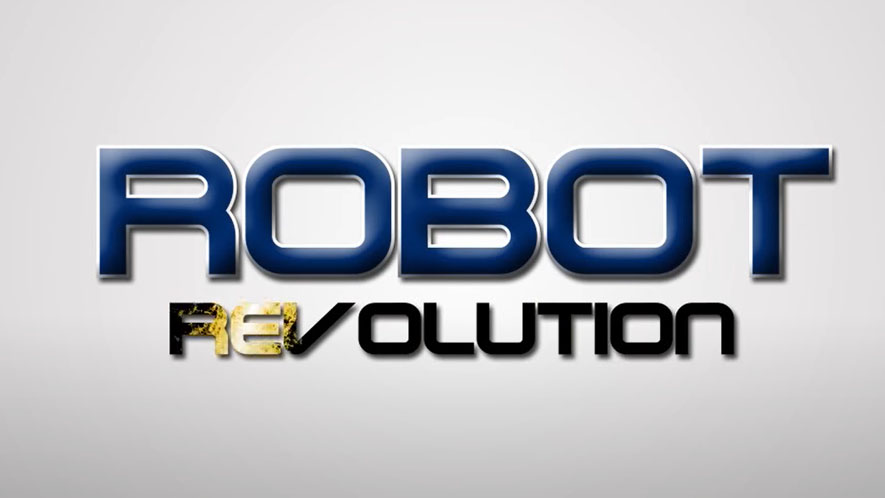Watch the Robot Revolution!
Robot Revolution
Robot comes from the greek word “Robota” which means “Forced Work or Labor”. The first recorded mention of a robot comes from Leonardo Da Vinci all the way back in 1495. He wrote down his thoughts about ‘Mechanical Knights’ who would help in battle. We use the word “Robot” today to mean any man-made machine that can perform work or other actions normally performed by humans either automatically or by remote control. Robotics is the science and study of robots. Robotics technology was first developed in the United States. But Japanese manufacturers were the first to fully embrace Robotics. Today Japan is not only one of the major users of manufacturing robots.
It is also the dominant manufacturer of industrial robots.
The first working robots was introduced in 1961. It worked on a production line making cars for Ford.
By 2019 household robots are ubiquitous and reliable.
By 2015-2012 Every South Korean and many European households will have a robot quitous and reliable.
By 2017 Medical robots performing low-invasive surgery
By 2015 Robots will routinely carry out surgery
By 2022 Intelligent robots that sense their environment that makes decisions, and learn are used only in 30% households and organizations
Caterpillar Inc, plans to develop remote controlled machines and expects to develop fully autonomous heavy robots by 2021.
Some cranes already are remote controlled.
Robots are increasingly used in manufacturing (Since the 1960’s)
In the auto industry they can amount for more than half of the “labor”.
There are even “Lights off” factories such as an IBM keyboard manufacturing factory in Texas that is 100% automated.
By 2030 robots capable of performing at human level at most manual jobs Marshall Brain[7]
By 2043 Robots (Home Automation Systems) performing most households tasks, Helen Greiner, Chairman of IROBOT[8]
By 2050 Robot “Brains” based on computers that execute 100 trillion instructions per second.
Will start rivaling human intelligence[9]
By 2015 one third of us fight strength will be composed of robots- US Department of defense.
By 2035 First completely autonomous robot soldiers in operation – US Department of defense[10]
By 2013-2014 massive growth in agricultural robots research.
By 2017-2019 household robots with full use.
By 2013-2017 Massive growth for robots that care for elderly research.
By 2017 Medical Robots Performing low-invasive Surgery.
By 2019 Household robots with full use.
By 2019 = 2021 Nano robots will start to be used.
According to Research Commissioned in The UK Office of Science and Innovation’s Horizon Scanning Centre
Robots could one day demand the same citizen’s rights as humans, the study also warns that the rise of Robots could put a strain on resources and environment.
By 2018 Exoskeletal, robotic leg prosthesis allow the paraplegic to walk.
The robotics industries association (RIA) reports that an estimated 178,000 industrial robots are in use in the United States as of 2008. up from 82,000 in 1998.
The product of the Bipedal Robots that Mimic Human movement are being created around the globe.
Honda Motor Comapany’s ASIMO (Advance Step in Innovative Mobility) Robot is considered the world’s most advance humanoid robot.It can climb stairs, walk, talk, dane, and even communicate and interact via its voice and facial recognition systems.
Honda plans to one day market the robot as an assisted-living companion for the disabled and elderly.,
Super robots that can perceive, intuit, adapt, think,and even simulate feelings much like humasn, will practicable before the year 2030.
To some the future of robotics has never been brighter.
Robots are prospective machines whose application area is widening’ = The Author of the Theory of Applied Robotics: Kinetics, Dynamics, and Control
Robots are poised to saturate every aspect of our Culture, from medicine,science and industry to Artworks, toys and household appliances, navigation technologies such as the Global Positioning System (GPS) are allowing industrial robots to move around the world.
GPS in conjunction with the Inertia Navigation Systems and the booming field of silicon Micros-electromechanical systems(MEMS)
Are impactic robotic from simple automated lawn mowers to complex airplane control systems.
Robotics are reaching the micro-level with the exploration of robotic water “Insects” equipped with the biomechanical Sensors that could be used as environmental monitors.
The current prototype weighs less than a gram and draws power from ultra-thin electrical wires.
And taking their place among the rest of society, performing tasks once imagined only in science fiction.
If robotics experts and forecasters are correct, people will soon see robots leaving the factory.
The military use robots for many different tasks, ranging from scouting enemy territory,
to more complicated tasks like the clearing of landmines they can even be used underwater,
In the next two decades robots will be capable of replacing the humans in most manufacturing jobs,
Being the police office or a fireman is a dangerous job.
They will be replaced by robots,
Robot Police Officers will be sent to the scene of the crime to stop it.
No strings attached! Robotics expert Henrick Christensen predicts human will be having sex with robots within four years.
Robotics will remain vital in the decades to come due to expanding scientific fields and increasing demand.
For more affordable and sophisticated methods of accomplishing common tasks.
In space robots can perform many tasks that could be impossible for humans in such hostile atmosphere
One robot is currently helping astronauts to rebuild the International Space Station.

